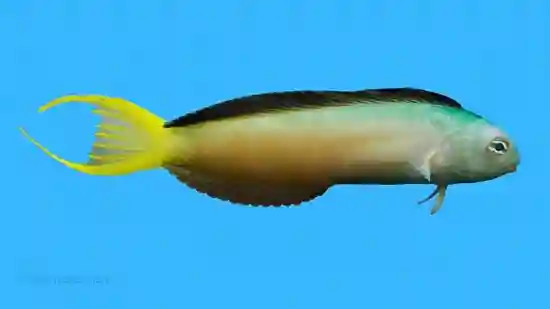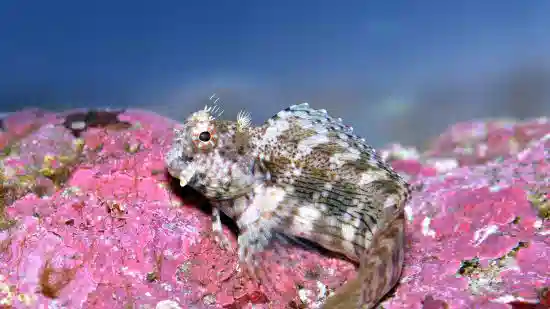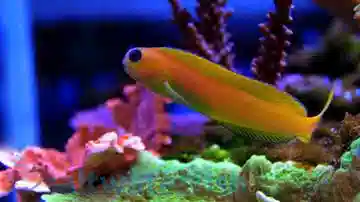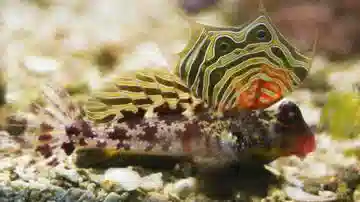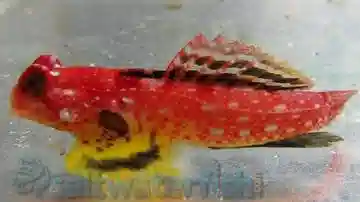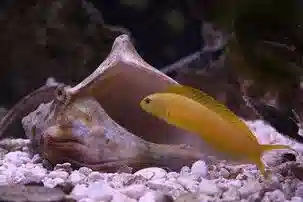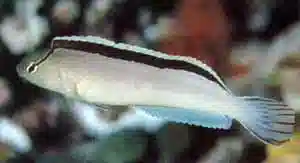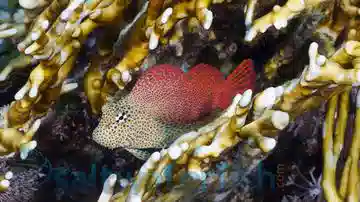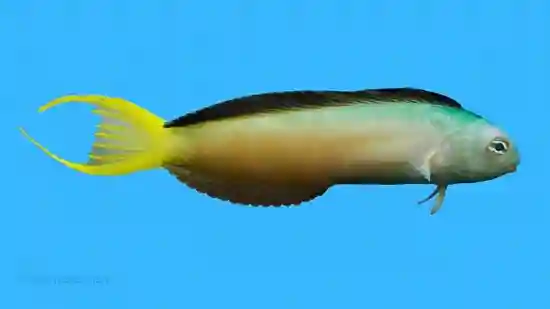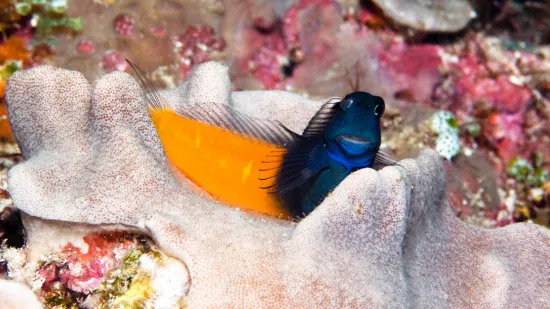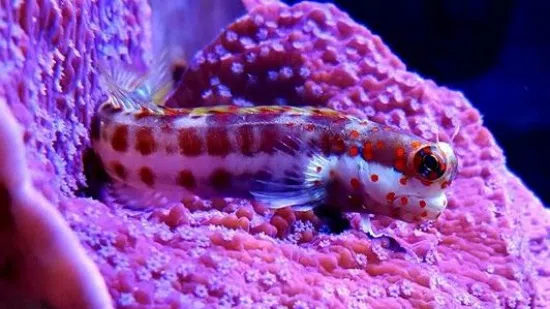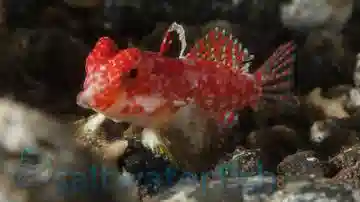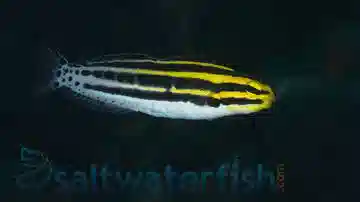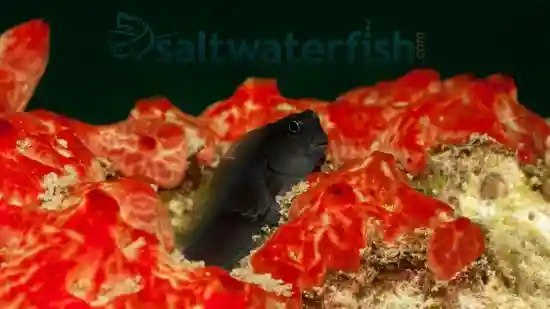Blennies In Saltwater Aquariums: FAQ
Blennies are a diverse group of small, reef-friendly fish with diets that vary by species. In general, they are hardy and adaptable feeders, making them excellent choices for both beginner and advanced reef keepers. Knowing what blennies eat ensures they thrive and display their full personality in your aquarium.
Common foods blennies eat in aquariums:
Algae and biofilm: Many blennies, such as the Lawnmower Blenny (Salarias fasciatus), graze continuously on microalgae and film algae, acting as natural tank cleaners.
Prepared foods: Spirulina-based pellets, algae wafers, and herbivore blends provide balanced nutrition.
Frozen foods: Mysis shrimp, brine shrimp, and finely chopped seafood are accepted by most blennies, especially omnivorous types.
Meaty options: Some blennies, like the Fang Blennies (Meiacanthus spp.), prefer a more carnivorous diet and will readily eat frozen and pellet foods.
Feeding tips:
Offer a varied diet: combine algae-based foods with frozen proteins for best health.
Feed small portions 2–3 times daily, as blennies are constant grazers.
Encourage natural grazing by maintaining healthy live rock surfaces.
One Saltwaterfish.com reviewer of the Golden Midas Blenny shared: “This is the most robust comical marine tank fish I have ever owned...very peaceful but loves to dive down, pick up sand, goes up to the top of the tank and blows the sand out of his mouth, so far, doesn't bother my corals much but it's a blast to watch...thinks he's the star of the tank...what a hoot to watch\!\!\!”*.
Bottom line: Blennies eat a mix of algae, pellets, frozen foods, and small meaty items depending on the species. Herbivorous blennies help with algae control, while omnivorous and carnivorous types benefit from varied diets. With proper feeding, blennies thrive as hardy, useful, and full-of-personality reef fish, backed by Saltwaterfish.com’s 8-Day Live Guarantee.
Yes, most blennies are considered reef safe, making them popular additions to saltwater aquariums with corals and invertebrates. However, because blennies are a diverse group, their reef compatibility depends on the species and the tank conditions you provide.
Reef-safe blennies (excellent choices for corals):
Lawnmower Blenny (Salarias fasciatus) – One of the best algae grazers for reef tanks; constantly eats film and hair algae without harming corals.
*Tailspot Blenny (Ecsenius stigmatura) – Small, peaceful, and safe with all corals. A favorite for nano reefs.
*Bicolor Blenny (Ecsenius bicolor) – Hardy and reef safe, though occasional reports of nipping at soft coral polyps occur if underfed.
*Fang Blennies (Meiacanthus spp.) – Known for their bright colors and venomous fangs (defensive only, harmless to tankmates); entirely reef safe.
Blennies to watch with caution:
Some algae-grazing blennies may nip at fleshy corals or clam mantles if they are underfed or there is insufficient algae in the tank.
Larger, more aggressive species (e.g., Rock Blennies) may not mix well in smaller reef systems.
One Saltwaterfish.com reviewer of the Scooter Blenny shared: “Great fish\! The best looking in the batch of livestock I received. It's doing great in the tank.”.
Pro tips for reef safety with blennies:
Keep them well-fed with algae-based foods to reduce the chance of coral nipping.
Provide plenty of rockwork and grazing surfaces.
Avoid mixing multiple algae-grazing blennies in smaller tanks, as they may fight over territory.
Bottom line: Blennies are generally reef safe, with species like Lawnmower, Tailspot, and Fang Blennies being excellent coral-friendly additions. With proper feeding and tank conditions, they help control algae while adding personality and utility to your reef, backed by Saltwaterfish.com’s 8-Day Live Guarantee.
Yes, blennies are naturally shy and often spend long periods hiding, especially when first introduced to a new aquarium. Unlike open-water swimmers such as tangs or wrasses, most blennies prefer to perch in rock crevices, burrows, or holes, darting out only to feed or graze. This behavior is completely normal and part of what makes them fascinating “character fish” in reef tanks.
Why blennies hide:
Acclimation stress: Newly added blennies may hide for days until they feel secure.
Territorial nature: Many species choose a “home base” rock or hole and return to it regularly.
Tankmates: Aggressive or fast-moving fish can make blennies more reclusive.
Feeding style: Herbivorous blennies, such as the Lawnmower Blenny (Salarias fasciatus), may emerge only to graze on algae before retreating.
Nighttime behavior: Most blennies tuck into crevices to sleep and avoid predators.
Scientific studies confirm that blennies are cryptobenthic species adapted to living in and around reef crevices. Depczynski and Bellwood (2004) observed that most blennies rely heavily on the reef structure for shelter, venturing out only briefly to feed. This explains why aquarium blennies often hide for long periods, particularly when first introduced or housed with larger, more active fish.
One Saltwaterfish.com reviewer of the Flametail Blenny shared: “An awesome little beautiful Flametail Blenny who peacefully explores my large reef tank's caves. Almost always visible and active.”.
Pro tips to help your blenny feel comfortable:
Provide ample rockwork and caves. They need safe retreats.
Keep peaceful tankmates; avoid overly aggressive species that may intimidate them.
Ensure a steady supply of algae or prepared foods so they don’t have to compete for meals.
- Be patient as many blennies become bolder over time and may perch openly once acclimated.
Bottom line: A blenny hiding all the time is usually normal behavior, especially for new additions. With time, food security, and safe hiding places, most blennies gain confidence and start showing their quirky personalities, backed by Saltwaterfish.com’s 8-Day Live Guarantee.
Blennies are hardy saltwater fish, but like all reef inhabitants, their health depends on stable conditions, proper diet, and tank compatibility. A healthy blenny will display a mix of natural behaviors, steady appetite, and vibrant coloration.
Signs of a healthy blenny:
Active grazing or perching: Herbivorous species like the Lawnmower Blenny (Salarias fasciatus) should be seen grazing on algae or calmly perching on rockwork.
Clear eyes and skin: No signs of cloudiness, lesions, or white spots (which may indicate ich).
Bright coloration: Healthy blennies maintain consistent color; dullness can signal stress or illness.
Strong appetite: They should eagerly eat algae, pellets, or frozen foods, depending on the species.
Steady breathing: Gills should move at a calm, regular pace. Rapid breathing can signal poor water quality or disease.
Curiosity and awareness: While many blennies are shy, healthy ones will cautiously observe tank activity and retreat only when startled.
Warning signs of poor health:
Refusing food for more than a few days.
Spending all their time hidden without emerging to graze.
Rapid breathing or gasping at the surface.
Visible parasites, wounds, or fin damage.
Emaciation or sunken belly (especially in herbivorous species that need constant grazing).
One Saltwaterfish.com reviewer of the Bicolor Blenny shared: “Love these little fish. They have so much personality, they are very feisty little fish. Love how they stick up for themselves. Once they have established their territory they defend it to the max. No they are not aggressive, just stick up for themselves”.
Pro tips for keeping blennies healthy:
Provide a mature tank with natural algae or supplement with spirulina-based foods.
Maintain stable reef water parameters (salinity 1.024–1.026, nitrates \<10 ppm).
Avoid aggressive tankmates that may stress or bully them.
- Use a quarantine tank to observe new arrivals before adding them to your reef.
Bottom line: A healthy blenny shows good appetite, bright coloration, normal breathing, and natural perching or grazing behaviors. By providing stable water, algae sources, and safe tankmates, your blenny will thrive and show its full quirky personality, backed by Saltwaterfish.com’s 8-Day Live Guarantee.
Yes, many blennies are considered excellent beginner fish for saltwater aquariums. They are hardy, adaptable, relatively inexpensive, and full of personality, which makes them ideal for new reef keepers. Their small size and low-maintenance feeding habits also make them a practical choice for tanks of various sizes.
Why blennies are beginner-friendly:
Hardy and adaptable: Most blennies tolerate a wide range of reef-safe water conditions, provided parameters remain stable.
Peaceful temperament: While slightly territorial toward their own kind, blennies are generally calm and coexist well with clowns, gobies, and tangs.
Useful algae grazers: Species like the Lawnmower Blenny (Salarias fasciatus) help control nuisance algae, reducing maintenance for new aquarists.
Small size: Many species, such as the Tailspot Blenny (Ecsenius stigmatura), stay under 4 inches, making them suitable for smaller reef systems.
Easy to feed: They accept prepared algae wafers, spirulina pellets, and frozen foods, making diet management simple.
Best beginner-friendly blennies:
Lawnmower Blenny – Great algae eater and very hardy.
Tailspot Blenny – Compact, peaceful, and perfect for nano reefs.
Bicolor Blenny – Brightly colored, hardy, and adaptable.
Midas Blenny – Recognized in reef / beginner fish guides as a peaceful, adaptable species.
Cautions for beginners:
Avoid keeping multiple algae-grazing blennies in small tanks, as they may fight over territory.
Some blennies may nip at fleshy corals or clam mantles if underfed.
Like most reef fish, they need a secure lid, blennies are known jumpers.
One Saltwaterfish.com reviewer of the Striped Blenny shared: “A cute, little, lively Striped Blenny \- Captive Bred that brings a lot of character to your tank. Seems to play well with others and makes a welcome addition while being an easy keeper.”.
Bottom line: Blennies are among the best beginner saltwater fish, combining hardiness, algae control, peaceful behavior, and quirky personalities. With proper feeding and a secure tank, they’re a reliable and entertaining first choice, backed by Saltwaterfish.com’s 8-Day Live Guarantee.
Blennies are quirky, hardy fish that bring both personality and utility to reef aquariums. Most are small, peaceful, and reef safe, making them a great choice for both beginners and experienced hobbyists. The best blennies for reef tanks are those that help control algae, coexist peacefully with corals and inverts, and adapt easily to prepared foods.
Top blennies for reef aquariums:
Lawnmower Blenny (Salarias fasciatus) – A favorite among reef keepers for its nonstop grazing on nuisance algae. Hardy, functional, and full of character.
*Tailspot Blenny (Ecsenius stigmatura) – Compact (under 3 inches), peaceful, and brightly marked with an orange tail spot. Perfect for nano and mid-sized reefs.
*Bicolor Blenny (Ecsenius bicolor) – Hardy and entertaining, with a half-orange, half-brown body. Generally reef safe, though may nip at soft corals if underfed.
*Fang Blennies (Meiacanthus spp.) – Strikingly colored, peaceful, and entirely reef safe. Their mild venom is only for defense and poses no threat to corals, inverts, or humans in aquariums.
*Midas Blenny (Ecsenius midas) – Larger (up to 6 inches), golden in color, and more of a plankton feeder than an algae grazer. Known for its graceful swimming and reef safety.
Why these species stand out:
They are peaceful with clowns, gobies, tangs, and most reef-safe fish.
They won’t harm corals or ornamental invertebrates when properly fed.
They offer added benefits, like algae control from the Lawnmower and Tailspot Blennies, or constant swimming activity from the Midas Blenny.
One Saltwaterfish.com reviewer of the Pictus Blenny shared: “Very animated. So much fun to watch. Its face reminds me of the crab in the song "Shiny" in the movie Moana. Gets along well with all the other fish in my nano tank.”.
Pro tips for success:
Provide live rock and algae growth for grazing species.
Feed a mix of spirulina pellets, algae wafers, and frozen foods.
- Keep only one algae-grazing blenny per tank unless in very large systems to prevent territorial disputes.
Bottom line: The best blennies for a reef tank include the Lawnmower, Tailspot, Bicolor, Fang, and Midas Blennies. These species combine hardiness, utility, and personality, making them standout choices for vibrant and balanced reef aquariums, backed by Saltwaterfish.com’s 8-Day Live Guarantee.
Blennies are hardy fish, but like all saltwater species, they can be sensitive to the stress of shipping. Proper acclimation is essential to ensure your blenny transitions smoothly from the shipping bag to your reef tank, reducing stress and maximizing survival.
Step-by-step acclimation process for blennies:
Float the sealed bag – Place the shipping bag in your aquarium for 15–20 minutes to equalize temperature.
Open into a container – Carefully pour the fish and shipping water into a clean bucket or specimen container.
Start drip acclimation – Use airline tubing to slowly drip tank water into the container (2–4 drops per second). Continue for 45–60 minutes, gradually doubling the water volume.
Transfer with a net – Gently net the blenny and place it into your tank (or quarantine tank). Never add shipping water to your system.
Lights off – Keep the aquarium lights dimmed or off for a few hours to reduce stress and give your blenny time to settle.
Special considerations for blennies:
Provide hiding spots: Blennies are cryptic by nature. Ensure your tank has live rock and crevices so they can claim a safe territory.
Feed early: Offer spirulina pellets, algae wafers, or frozen mysis/brine within the first 24 hours to confirm your blenny is eating.
Use a lid: Blennies are known jumpers, especially when stressed during acclimation. A secure mesh or glass cover is essential.
Quarantine recommended: A 2–4 week quarantine helps monitor for parasites like ich or flukes before introducing them to your display tank.
One Saltwaterfish.com reviewer of the Ruby Red Dragonet shared: “Very nice reef fish. Ruby Red Dragonet cleans detritus in the live rock. Doesn't intrude on the reef. Easy keeper.”*.
Bottom line: To acclimate a blenny after shipping, use drip acclimation for 45–60 minutes, provide rockwork for hiding, and keep a secure lid. With patience and care, your blenny will settle quickly and begin grazing or perching in your reef tank, backed by Saltwaterfish.com’s 8-Day Live Guarantee.
Blennies are small, hardy saltwater fish that adapt well to a variety of aquariums, but the minimum tank size depends on the species. Some blennies thrive in nano reefs, while others need more space to graze, explore, and establish territories. Choosing the right size tank ensures your blenny stays healthy and stress-free.
General tank size guidelines for popular blennies:
Nano-friendly blennies (10–20 gallons minimum): Tailspot Blenny, Bicolor Blenny and other small Ecsenius species. Peaceful and compact, making them excellent for nano reefs.
Medium-sized blennies (30 gallons minimum): Lawnmower Blennies and Starry Blennies need room to roam.
Larger blennies (50–70 gallons minimum): Midas Blennies and Smith’s Fang Blennies are more active than most blennies, requiring swimming space.
Specialty species (55+ gallons): Larger Rock Blennies or multiple blennies (only in very large setups to avoid territorial disputes).
One Saltwaterfish.com reviewer of the Tailspot Blenny shared: “Awesome little guy. Has made his home in a large empty shell in the front of the tank. Love watching him pop his head out and run around for a minute and dive back into the shell..
Pro tips for blenny tank sizing:
Always choose the tank size based on adult size, not juvenile size.
Provide plenty of live rock for grazing and hiding.
- Avoid keeping multiple algae-grazing blennies in small systems, as they may fight over territory.
Bottom line: The minimum tank size for blennies ranges from 10 gallons for tiny Tailspot Blennies to 50+ gallons for larger species like the Midas Blenny. Most popular algae grazers, like the Lawnmower Blenny, thrive in tanks of 30 gallons or more, ensuring enough space for grazing and natural behavior, backed by Saltwaterfish.com’s 8-Day Live Guarantee.
Yes, it’s possible to keep more than one blenny in the same aquarium, but success depends on species choice, tank size, and aquascape design. Blennies are territorial fish, and many will defend their favorite rock or burrow against intruders, especially if another blenny of the same species is present in a small system.
General rules for keeping multiple blennies:
Avoid duplicates in small tanks: Keeping two of the same species (e.g., two Lawnmower Blennies (Salarias fasciatus)) in a 30–40 gallon tank will almost always lead to aggression.
Mix across genera: A Lawnmower Blenny may coexist peacefully with a Fang Blenny (Meiacanthus spp.) or Midas Blenny (Ecsenius midas) because their diets and territories differ.
Tank size matters: In general, you’ll need 55–75+ gallons with plenty of rockwork to successfully house multiple blennies. Larger systems diffuse territorial disputes.
Introduce carefully: Adding multiple blennies at the same time, or rearranging rockwork when introducing a second blenny, can reduce territorial aggression.
Blennies that mix well in larger tanks:
Lawnmower Blenny (algae grazer) \+ Fang Blenny (plankton feeder).
Tailspot Blenny (tiny and peaceful) \+ Midas Blenny (active swimmer).
Algae-grazing blenny \+ carnivorous/omnivorous blenny (different feeding niches).
One Saltwaterfish.com reviewer of the Red Scooter Blenny shared: “Scooter Blenny: Red \- South Asia Great addition to 28g Biocube reef tank. Very healthy and active. Add great color to coral tank.”.
Pro tips for multiple blennies:
Provide abundant live rock with caves and crevices.
Avoid mixing multiple algae grazers in tanks under 75 gallons.
Watch closely after introduction, separation may be necessary if aggression occurs.
Bottom line: You can keep more than one blenny in your aquarium if you mix different species, provide at least 55–75 gallons of space, and build plenty of rockwork for territories. With careful planning, multiple blennies can coexist and add even more personality to your reef, backed by Saltwaterfish.com’s 8-Day Live Guarantee.
Introducing a new blenny to an established reef aquarium requires patience and planning. While blennies are hardy and generally peaceful, they are also territorial, and improper introductions can lead to stress or aggression. By following best practices, you can help your new blenny acclimate smoothly and coexist with existing tankmates.
Steps for introducing a blenny to an established tank:
Acclimate slowly: Use drip acclimation for 45–60 minutes after shipping to reduce stress and match water parameters.
Lights out: Add the blenny with tank lights dimmed or off for a few hours. This prevents established fish from immediately noticing or harassing the newcomer.
Provide hiding spots: Blennies feel secure when they can claim a hole, crevice, or perch. Ensure your rockwork offers multiple territories.
Use an acclimation box (optional): Floating boxes or breeder nets let the blenny adjust to tank conditions while other fish see but can’t attack it.
Feed generously: A well-fed community is less aggressive. Offer algae wafers, spirulina pellets, or frozen mysis to distract tankmates.
Monitor closely: Watch for chasing or aggression, especially from other blennies or bottom dwellers. Rearranging rockwork can help break up established territories if needed.
Species considerations:
Lawnmower Blennies (Salarias fasciatus) are hardy but territorial toward similar algae grazers.
Avoid introducing multiple algae-grazing blennies in small tanks, as they often fight for the same niche.
One Saltwaterfish.com reviewer of the Starry Blenny shared: “Beautiful specimen. Got him in great shape. However, he's not very nice. He took over the hidey hole of my diamond watchman goby and harasses him constantly. The starry blenny I have eats a little algae, but he also eats frozen mysis shrimp and flake food.”.
Bottom line: To introduce a new blenny to an established tank, use drip acclimation, dim lights, provide rockwork for territories, and monitor aggression. With these precautions, most blennies settle quickly and add both utility and personality to your reef, backed by Saltwaterfish.com’s 8-Day Live Guarantee.
Blennies are hardy saltwater fish, and with proper care, they can live surprisingly long in captivity. On average, most blennies live 3–5 years in a home aquarium, though some species when provided with excellent conditions may reach 6–8 years. Their lifespan depends on species, diet, tank size, and overall husbandry.
Typical lifespans by species:
Lawnmower Blenny (Salarias fasciatus) – 3–5 years, sometimes longer in large, established reefs.
*Tailspot Blenny (Ecsenius stigmatura) – 3–4 years; nano-friendly but still requires stable water quality.
*Midas Blenny (Ecsenius midas) – 4–6 years; more active, larger blenny with a slightly longer lifespan when fed a varied diet.
*Fang Blennies (Meiacanthus spp.) – 4–5 years; hardy, reef-safe, and generally long-lived in peaceful setups.
What influences lifespan in aquariums:
Stable water quality: Blennies are hardy but still sensitive to ammonia, nitrite, and rapid parameter swings.
Diet: Herbivorous species need constant access to algae or spirulina-based foods; omnivorous and planktivorous blennies thrive on a mix of frozen mysis, pellets, and algae.
Stress and aggression: Housing multiple algae-grazing blennies in small tanks often shortens lifespan due to stress.
Tank size: Larger tanks (30–50+ gallons, depending on species) allow more natural grazing and reduce territorial disputes.
One Saltwaterfish.com reviewer of the Captive Bred Blackline Blenny shared: “The Blackline Blenny \- Tank Raised, was received in great shape and has added life to my saltwater aquarium. Thanks”.
Pro tips for maximizing blenny lifespan:
Feed a varied, algae-rich diet to prevent malnutrition.
Provide plenty of rockwork for grazing and hiding.
Keep tank lids secure, jumping is a common cause of premature loss.
- Quarantine new arrivals to avoid disease introduction.
Bottom line: Blennies typically live 3–5 years in a home aquarium, with some reaching 6–8 years under optimal conditions. By maintaining stable water, offering a balanced diet, and reducing stress, you’ll enjoy years of algae control and quirky behavior, backed by Saltwaterfish.com’s 8-Day Live Guarantee.
Yes, blennies and clownfish can live together peacefully in the same aquarium, and they are one of the most popular combinations in reef tanks. Both species are hardy, beginner-friendly, and reef safe, making them excellent community fish when housed under the right conditions.
Why blennies and clownfish get along:
Different niches: Clownfish typically stay close to an anemone or host coral, while blennies perch in rock crevices or graze on algae. This natural separation reduces competition.
Compatible temperaments: Most blennies are peaceful bottom dwellers, and clownfish defend only their small host area. Aggression rarely overlaps.
Similar tank requirements: Both species thrive in reef systems with live rock, stable water parameters, and moderate flow.
Best blennies to pair with clownfish:
*Lawnmower Blenny (Salarias fasciatus) – Great algae grazer, hardy, and full of character.
*Tailspot Blenny (Ecsenius stigmatura) – Peaceful, nano-sized option perfect for smaller tanks with clowns.
Things to watch for:
In very small aquariums (\<20 gallons), space can be tight, and territorial disputes may arise. A minimum of 30 gallons is recommended for a clown-blenny combo.
Some blennies (like Bicolor Blennies) may occasionally nip at corals if underfed. Keeping them well-fed prevents this behavior.
Always use a secure lid, blennies are jumpers.
One Saltwaterfish.com reviewer of the Two Spot Blenny shared: “This is a great Two Spot Blenny who showed up healthy and happy. He was shy at first in my quarantine tank but after moving him over to the main tank he has been quite the showman. Beautiful fish to add to a reef tank.”.
Bottom line: Blennies and clownfish are highly compatible tankmates. With a 30+ gallon tank, stable water, and plenty of rockwork, they coexist peacefully, providing both algae control and lively personality to your reef, backed by Saltwaterfish.com’s 8-Day Live Guarantee.



